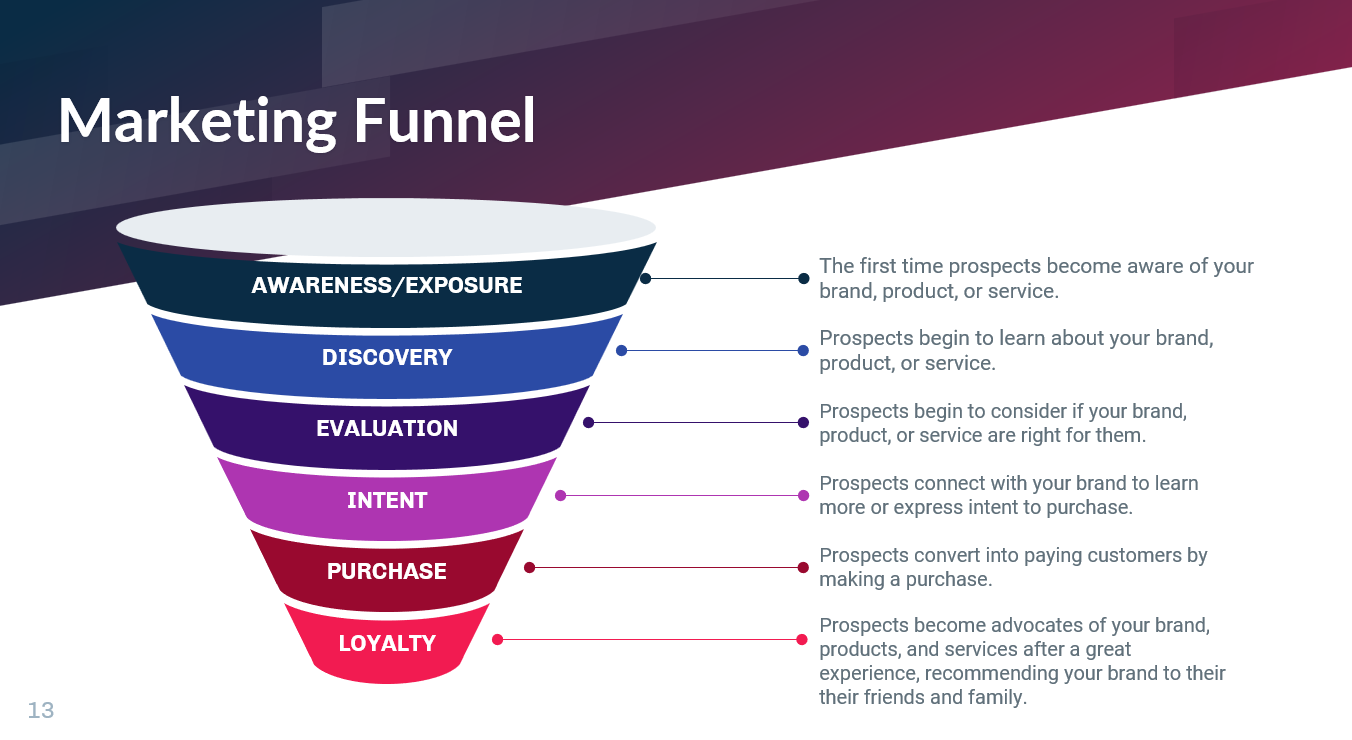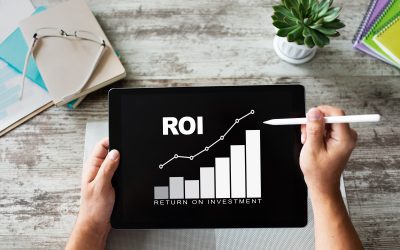
THE SIX STAGES OF THE MARKETING FUNNEL
The marketing funnel represents all the stages of the entire customer journey, from the preliminary stage, where the customer learns about your business, to the final stage, where they convert into loyal customers. Understanding each step of the customer journey will help you develop marketing strategies and content that supports each stage of the marketing funnel, ultimately converting more prospects into customers.
In theory, prospects would work through the funnel in a linear fashion. However, the truth of the matter is, depending on the prospect, their first interaction with the brand could occur at any stage.
For example, a prospect may become aware of the brand through a word-of-mouth referral and already be at the “Intent” stage before ever engaging with the brand.
Or, a prospect may already be in the market for further education and may run across your brand during their personal evaluation stage of researching and comparing options.
Because the funnel isn’t always a linear journey, it’s vital that all elements of marketing be consistent in messaging, cohesive in presentation, and constantly calling prospects to action.
Awareness
The awareness stage is the first stage of the marketing funnel, where potential customers become aware of a brand or product. This stage aims to increase brand visibility and reach as many people as possible. This can be achieved through various marketing channels, such as:
- Social Media: Platforms like Facebook, Instagram, and Twitter can be used to increase brand awareness by reaching a large audience with targeted advertising and engaging content.
- Paid Advertising: Paid advertising channels such as Google AdWords, display ads, and influencer sponsorships can be used to increase brand visibility and drive traffic to a website.
- Content Marketing: Creating valuable content such as blog posts, videos, and infographics can be used to educate potential customers about a brand and its products or services.
- Public Relations: Press releases, media coverage, and events can be used to increase brand visibility and credibility.
- Search Engine Optimization: Optimizing a website for search engines can increase brand visibility by improving a website’s search engine ranking, making it more likely to appear on the first page of search results for relevant keywords.
- Referral Marketing: Encourage existing customers to refer their friends and family to your brand, to increase the brand’s visibility and trust.
It is important to note that in this stage, the goal is not to make a sale, but rather to make people aware of the brand and its offerings. This will help to build a foundation of potential customers who will move further down the funnel in the future.
Discovery
The discovery stage is the second stage of the marketing funnel, where potential customers explore and learn more about a brand or product. This stage aims to provide potential customers with information that will help them understand the value of a product or service. This can be achieved through:
- Product Demos: Providing potential customers with a demonstration of a product or service can help them understand how it works and its capabilities. This can be done through videos, virtual tours, or live demonstrations.
- Case Studies: Sharing real-life examples of how a product or service has helped other customers can help potential customers understand the value of the offering.
- Testimonials: Sharing customer reviews and testimonials can help build trust and credibility for a brand and its products or services.
- Free Trials: Offering a free trial of a product or service can help potential customers experience it firsthand and understand its value.
- Webinars: Hosting webinars on relevant topics can be a great way to provide potential customers with valuable information and insights while building brand awareness.
- Whitepapers: Creating and sharing informative whitepapers can be a great way to provide potential customers with in-depth information on a specific topic or industry.
During this stage, the focus is on providing potential customers with the information they need to make an informed decision about a product or service. It is important to use clear and concise language, and to provide enough information to help them understand the value of the offering, but not too much that it becomes overwhelming.
Evaluation
The evaluation stage is the third stage of the marketing funnel, where potential customers evaluate whether a brand or product meets their needs. This stage aims to provide customers with the information they need to decide, such as pricing, features, and benefits. This can be achieved through:
- Product Comparison Charts: Providing potential customers with a side-by-side comparison of different products or services can help them understand the differences and make an informed decision.
- Free Trials: Offering a free trial of a product or service can help potential customers experience it firsthand and evaluate its value.
- Return Policies: Providing potential customers with a clear return policy can help build trust and reduce risk, making them more likely to make a purchase.
- Pricing Information: Providing clear and transparent pricing information can help potential customers understand the cost of a product or service and make an informed decision.
- Product Information: Providing detailed product information such as specifications, features, and benefits can help potential customers understand the value of a product and make an informed decision.
- Consultation: Offering a consultation service can be a great way to provide potential customers with personalized advice, and help them evaluate whether a product or service meets their specific needs.
During this stage, it is important to provide potential customers with all the information they need to make an informed decision, and to be transparent about any potential drawbacks or limitations of a product or service. It is also important to be responsive to any questions or concerns potential customers may have, so they can confidently make a decision.
Intent
The intent stage is the fourth stage of the marketing funnel, where potential customers express intent to buy a product or service. This stage aims to convert potential customers into paying customers. This can be achieved through:
- Special Promotions: Offering special promotions, discounts or coupons can help motivate potential customers to make a purchase.
- Targeted Advertising: Using targeted advertising to reach potential customers who have shown interest in a product or service can help to increase the likelihood of them making a purchase.
- Retargeting: Retargeting potential customers who have previously shown interest in a product or service can help to bring them back to the website and motivate them to make a purchase.
- Scarcity: Creating a sense of scarcity or urgency around a product or service can motivate potential customers to make a purchase before it runs out or the offer expires.
- Personalized Offers: Creating personalized offers or recommendations based on a customer’s browsing or purchase history can help to increase the likelihood of them making a purchase.
- Follow-up: Following up with potential customers who have shown interest in a product or service can help to keep the brand on their mind and motivate them to make a purchase.
During this stage, the main focus is on converting potential customers into paying customers by providing them with the right incentives and motivations. It is important to make it easy for customers to make a purchase, and to remove any obstacles that may be preventing them from doing so. Clear calls-to-action and a smooth checkout process can be helpful in this stage.
Purchase
The purchase stage is the fifth stage of the marketing funnel, where customers make a purchase and the transaction is completed. This stage aims to provide customers with a seamless, easy, and enjoyable buying experience. This can be achieved through:
- Streamlined Checkout Process: Making the checkout process as simple and straightforward as possible can help to reduce the risk of cart abandonment and increase the likelihood of a successful purchase.
- Mobile Optimization: Optimizing the buying experience for mobile devices can help to increase the likelihood of a purchase, as more and more customers are using their smartphones to make online purchases.
- Fast Shipping: Offering fast shipping options can help to increase customer satisfaction and loyalty.
- Secure Payment: Ensuring that the payment process is secure and that customers’ personal and financial information is kept safe can help to build trust and increase the likelihood of a purchase.
- Confirmation and follow-up: Sending a confirmation email or text message once the purchase is made can help to provide customers with peace of mind and increase their satisfaction with the buying experience. Following up with the customer to ensure they are satisfied with their purchase can also increase the chances of repeat business.
- Personalized and Human Touch: Personalizing the buying experience by adding a human touch, such as a thank you note or a call, can increase customer satisfaction and loyalty.
During this stage, the main focus is on providing customers with a positive buying experience that will encourage them to return in the future. It is important to make the process as smooth and easy as possible while also ensuring that the customer’s personal and financial information is kept secure. Additionally, providing great customer service during and after the purchase can help increase customer satisfaction and loyalty.
Loyalty
The loyalty stage is the final stage of the marketing funnel, where the goal is to create long-term, loyal customers who continue to buy from a brand over time. This can be achieved through:
- Customer Loyalty Programs: Offering rewards or incentives to customers who make repeat purchases can help to increase customer loyalty and encourage repeat business.
- Personalized Marketing: Creating personalized marketing campaigns based on a customer’s purchase history or browsing behavior can help to increase the relevance and effectiveness of marketing efforts.
- Excellent Customer Service: Providing excellent customer service can help to build trust and increase customer satisfaction, leading to increased loyalty.
- Follow-up: Following up with customers after a purchase to ensure they are satisfied and to address any concerns can help to increase customer satisfaction and loyalty.
- Community Building: Building a community of loyal customers through social media, email marketing, or in-person events can help to increase brand loyalty and advocacy.
- Continual Improvement: Continuously improving products, services, and the overall customer experience can help to increase customer satisfaction and loyalty over time.
During this stage, the main focus is on maintaining long-term relationships with customers by providing them with excellent service, relevant and personalized offers and building a sense of community. By focusing on customer retention, brands can reduce the costs associated with acquiring new customers and increase the lifetime value of existing customers.
It is important to note that the marketing funnel is not a one-time process, and customers may move back and forth between stages before making a purchase. Additionally, it is also important to track and measure the customer’s journey through the funnel to understand where most of the drop-offs happen, so that necessary improvements can be made to the customer journey.
Understanding your marketing funnel will help you craft effective conversion strategies for your business. Raine Digital helps businesses grow. Visit our website today to learn more about our services.



0 Comments